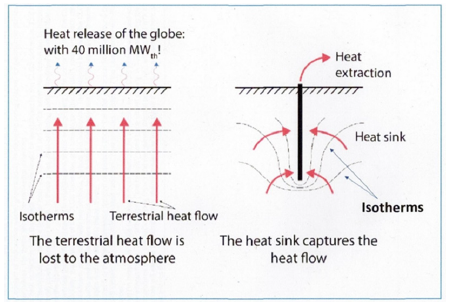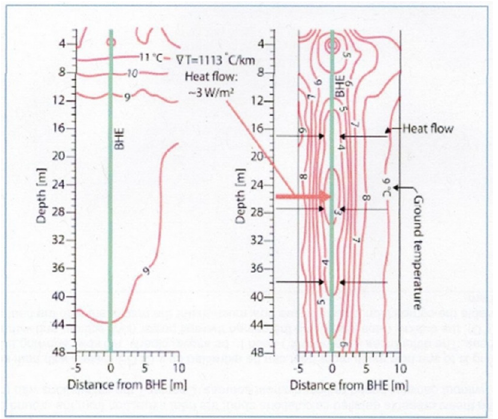- Submissions

Full Text
Aspects in Mining & Mineral Science
No Heat Mining in Utilizing Geothermal Resources
Ladislaus Rybach*
Institute of Geophysics ETHZ, CH 8092 Zurich, Sonneggstrasse 5, Switzerland
*Corresponding author:Ladislaus Rybach, Institute of Geophysics ETHZ, CH 8092 Zurich, Sonneggstrasse 5, Switzerland
Submission: April 26, 2024: Published: May 07, 2024

ISSN 2578-0255Volume12 Issue3
Abstract
The term Heat Mining is obsolete in geothermal energy utilization; it is proven that geothermal resources regrow like biomass; while mined-out mineral and/or fossil deposits are gone forever. Further it is shown that geothermal heat and fluid extraction for utilization create heat sinks and hydraulic minima, which automatically trigger natural forces to fill up the deficits. Geothermal resources regrow like biomass.
Keywords:Geothermal resource basis; Heat extraction; Heat replenishment; Numerical modelling; Field measurements; Resource renewability; Production sustainability
The Basics
The Earth’s interior is an immense heat store, is estimated to be around 1031J. Earth as a planet can afford to lose heat to the atmosphere (=the terrestrial surface heat flow, integrated over the Earth’s surface) with a thermal power of 40 million MW - without any cooling. While the heat ls lost, it gets constantly replenished by the decay heat of the natural radioactive isotopes of U, Th and K in the subsurface. As far as a more specific fraction of the globe is concerned, the continents (global surface area some 2*1014m2) and only the top 1km of the continental crust; then the heat content of this shell is still considerable, 3.8*108EJ. The world’s primary energy consumption is only about 500EJ. So, the geothermal resource base is immense; there is more than enough heat for geothermal uses.
Geothermal heat or fluid extraction at a given place creates heat sinks and hydraulic minima. These lead immediately to strong temperature and pressure gradients. Along these, strong heat and fluid inflow from the surroundings is established to fill up the deficits.
The Evidence
The situations and processes acting are demonstrated with the example of the ground-source geothermal heat pump; nowadays a widely used system to extract heat from the ground. Actually, this is one of the globally fastest growing renewable technologies and definitely the fastest growing segment in geothermal technology. The basic element of this system is the borehole heat exchanger (BHE). With this, heat can be extracted from the ground. It will be shown with what consequences. Figure 1 displays two situations, without heat extraction (left) and with heat extraction with a BHE (right).
In the case of heat extraction, the originally flat isotherm surfaces gradually get deformed, to form coaxial cylinder-shaped surfaces around the BHE. Numerical model calculations show that the developing isotherm surfaces get closer and closer to each other during heat extraction [1]. This leads to strong horizontal temperature gradients perpendicular to the cylinders, on the order of 1000 °C/km (normal geothermal gradients are around 30 °C/km). This also means strong heat flow densities (several W/m2 whereas average terrestrial heat flow is about 80mW/m2). Replenishment of the extracted heat is thus ongoing; without heat extraction, the terrestrial heat flow would be lost to the atmosphere at this site. That all this modelling-based effects really take place, has been proven by field measurements, as shown below.
Figure 1:Schematic illustration of the principle of geothermal heat extraction and production. Arrows indicate direction of heat flow. The left panel refers to a scheme without heat extraction: Here the isotherms are horizontal; the terrestrial heat escapes to the atmosphere (globally with 40 × 106 MWth power). The right panel refers to a scheme where heat inflow replenishes the heat sink, created by the heat extraction. In this case, the isotherms are increasingly deformed, and the heat flow lines are diverted towards the heat sink. Figure from Ryhach [7], modified.

The Proof
In an experimental setup at Schöffengrund-Schwalbach, near Frankfurt/Main, Germany, a test system has been installed and operated. A 50m deep BHE was surrounded by nine monitor boreholes at 2.5, 5, and 10 m distances, also 50m deep. In each of these monitor boreholes, as well as in the BHE, 24 sensors at 2m vertical distances in between have measured the temperatures. This arrangement yielded a total of 640 data points to depict the temperature field in the subsurface around the BHE. The temperature isotherm pattern, constructed from these data, is shown in Figure 2. For details, see Rybach & Sanner [2]..
Figure 2:Measured temperature distribution in the ground at the beginning of the monitoring period (left, on 1.10.1986, after a total of ca. 2 hours of test operation) and at the end of the first heating season (right, on 1.5.1987), at the ground-coupled heat pump test plant, Schwalbach, Germany. The narrow, cylindrical isotherm pattern represents strong heat inflow. The red arrow shows the maximum. After Rybach & Sanner [2], modified.

The field experiment clearly demonstrates that the cylindershaped isotherm system really develops around a BHE. The temperature gradient in this experiment exceeds the value of 1000 °C/km and the heat flow was about 4W/m2, whereas the normal geothermal gradient is 30 °C/km and normal surface heat flow is around 60mW/m2. The field measurements prove that natural forces govern the replenishment of utilized geothermal resources.
Thermal Depletion and Recovery
Experience shows that temperatures as well as heat content will decline during resource utilization, at the beginning quickly, then slower and slower¸ recovery is about the same: rapid at the beginning and then less and less. This has been evaluated by numerical modelling, by calculating the temperature changes in the vicinity of a BHE during heat extraction and the recovery phase starts. Figure 3 shows the temperature change at during an extraction phase of 30 years, and in a subsequent recovery phase .
Principally, the recovery period equals the operation period, the changing speed of recovery is similar to that of the decrease. In mathematical form, the decrease looks like y=exp (-ax) and the recovery like y=1–exp(-ax). Recovery duration is about the same as that of the production. The practically automatic resource refill guarantees production sustainability. For details, see Rybach & Eugster [1].
Figure 3:Calculated ground temperature change at a depth of 50m and at a distance of 1m from a 105m long BHE during a production period and a recovery period of 30 years each [1]. After 30 years of recovery the deficit (ε) is marginal.

The Implications
The above-described fundamental perceptions prove production sustainability of ground-source heat pump systems and are valid for other kinds of geothermal utilizations at greater depths, and also for power generation (from hydrothermal or Petro thermal resources) and direct use (from deep aquifers), e.g., for district heating (for details see Axelsson et al. 2022). In particular, the replenishment of a heat sink has its analogy in fluid production, and replenishment in a hydrothermal reservoir; the fluid extraction creates a hydraulic minimum, which leads to strong hydraulic gradients and corresponding inflow to refill the resource. In other words, as mentioned, geothermal resources regrow, like biomass. Further aspects of geothermal resources renewability and production sustainability are given in Rybach et al. [3], as well as in Axelsson [4].
Conclusion
There is no heat mining in utilizing geothermal resources. Because there is a fundamental difference between the mining of ores, coal, also of oil and gas, on one hand and the heat extraction from the ground for geothermal uses on the other. The removed minerals and hydrocarbons will never come back after their extraction, while the extracted geothermal heat will return, as quick as it has been taken out. There is ample evidence, theoretical and experimental (i.e. by numerical modelling and field experiments) to prove this, as demonstrated above. The production sustainability has also been marked; this nowadays a central endeavor, globally. The specific requirements and conditions like the sustainable production level have not been detailed out but can be found in one of the References [3]. Although the term “Heat Mining” has been used previously (even a textbook with this exists [5], nowadays it is obsolete and demonstrated above; it should be abandoned nowadays [6,7]. Geothermal resources regrow like biomass!
References
- Rybach L, Eugster WJ (2010) Sustainability aspects of geothermal heat pump operation, with experience from Switzerland. Geothermics 39(4): 365-369.
- Rybach L, Sanner B (2000) Ground-source heat pump systems - The European experience. Geo-Heat Center Bull 21(1): 16-26.
- Rybach L, Mégel T, Eugster WJ (2000) At what timescale are geothermal resources renewable? Proc World Geothermal Congress 2000, Kyushu-Tohoku, Japan, pp. 867-872.
- Axelsson G (2010) Sustainable geothermal utilization-Case histories, definitions, research issues and modelling. Geothermics 39(4): 283-291.
- Armstead HC, Tester JW (1987) Heat mining: A new source of energy. Chapman & Hall, London, p. 428.
- Axelsson G, Rybach L, Júlíusson G (2020) Sustainable management of geothermal production. Proceedings World Geothermal Congress, Reykjavik, Iceland.
- Rybach L (2021) Geothermal sustainability or heat mining? International Journal of Terrestrial Heat Flow and Applied Geothermics 4(1): 15-25.
© 2024 Ladislaus Rybach. This is an open access article distributed under the terms of the Creative Commons Attribution License , which permits unrestricted use, distribution, and build upon your work non-commercially.
 a Creative Commons Attribution 4.0 International License. Based on a work at www.crimsonpublishers.com.
Best viewed in
a Creative Commons Attribution 4.0 International License. Based on a work at www.crimsonpublishers.com.
Best viewed in 







.jpg)






























 Editorial Board Registrations
Editorial Board Registrations Submit your Article
Submit your Article Refer a Friend
Refer a Friend Advertise With Us
Advertise With Us
.jpg)






.jpg)














.bmp)
.jpg)
.png)
.jpg)










.jpg)






.png)

.png)



.png)






